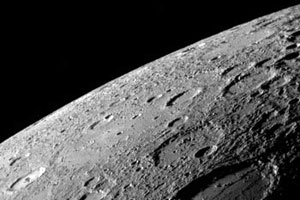 A limb shot of Mercury's horizon taken by the
A limb shot of Mercury's horizon taken by the
MESSENGER spacecraft on January 14, 2008.
Photo Credit "NASA/MESSENGER"
If you can take a name like "Mercury Surface, Space Environment, Geochemistry and Ranging" and craft it into a neat acronym like MESSENGER, then you may have a future working with NASA....
And no, this blog isn't about NASA acronymizations, but rather the heat-resistant robot behind one of them. MESSENGER is the space probe that NASA sent to Mercury to give the Solar System's innermost planet the first up-close look since 1975, when Mariner 10 flew by.
Though MESSENGER's main mission will begin in earnest when it returns to Mercury and finally settles into an orbit around the planet, on March 18th 2011, we were given a tantalizing peak last January 14th when the probe made its initial flyby.
What did this quick, on the fly snapshot tell us that we didn't know before? Well-a lot, considering Mercury has been one of the least understood planets in the Solar System, and was for a long time thought to be similar in character to our own Moon. Mercury is shaping up to be a lot less like Earth's Moon than its gray, cratered, airless appearance would mislead.
